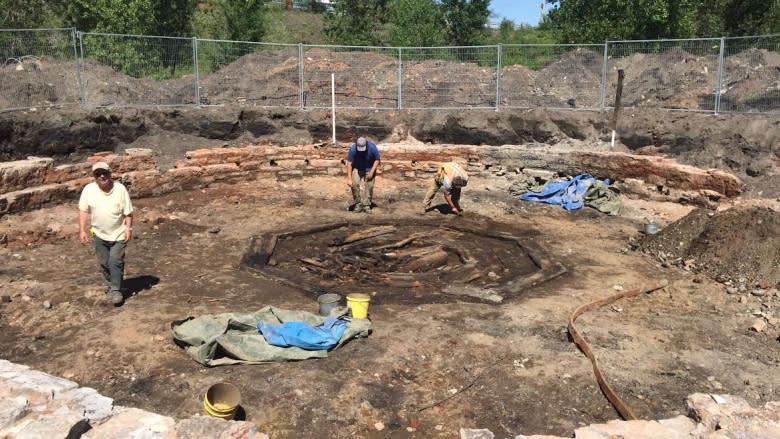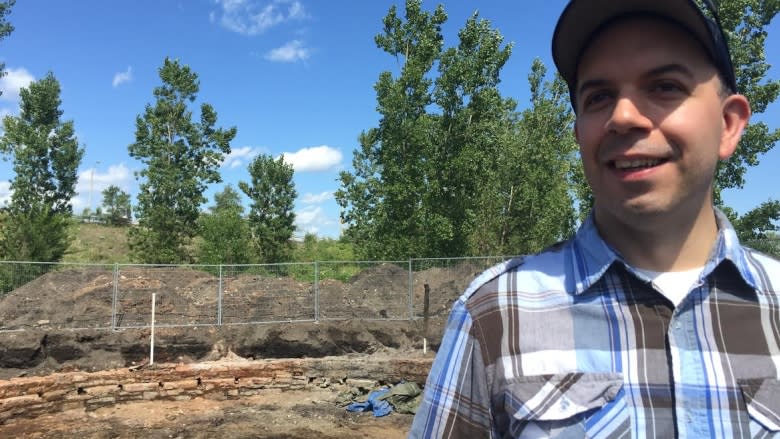Archaeologists make 'thrilling' Ottawa rail history discovery near LRT line
As construction of Ottawa's $2.1-billion light rail network chugs along, archaeologists have unearthed a 145-year-old slice of rail history near Bayview station in the city's Hintonburg neighbourhood.
The railway turntable, also known as a wheelhouse, was operated by the Ottawa St. Lawrence Railways. It was discovered two weeks ago on the site where Trinity Developments is planning to build several mixed-use condo towers.
In its day, trains entered the limestone turntable from the east and were shunted manually along a wooden pivot line in the centre — or, they entered one of three spur lines that made their way into a maintenance house.
Most of the turntable's wall and the three spur lines were uncovered more or less intact, although a fire that happened around 1883 has left the stone a burnt orange colour.
"This is great, mostly because the turntable [discovery] is so unexpected, because of the size of it and the state of the preservation," said Jeff Earl, who co-owns Past Recovery Archaeological Services Inc., the Perth-area company that began the excavation about three weeks ago.
The excavation site is on Albert Street, just north of the City Centre Building and next to the Bayview stop of the O-Train.
Earl, whose firm was hired by Trinity Developments to excavate the site and record it for posterity with drawings and photographs, said many curious people stop and watch the work.
Some tell him the excavated turntable looks like the remains of a Roman coliseum.
"I'm personally interested in old industrial sites, and this fits all the bills for me," Earl said. "It's just great."
The limestone walls, which measure a few metres high, were likely built hastily due to the competition among railways in the late 19th century, Earl said. The turntable was used for trains that were transporting giant timber logs from the sawmills at Chaudière Falls to the St. Lawrence River at Prescott, Ont., he said, and then on to ships bound for Europe.
"The stone work itself was pretty rushed. So it looks like they were in a hurry to get their spur line completed," said Earl. "I'm just glad we're able to help preserve some of the information and help tell the story here."
Railway gave birth to Hintonburg
The rail turntable discovery is "thrilling," said Dave Allston, a local historian and writer The Kitchissippi Museum, a blog about the history of west Ottawa.
"It's like a window into the early days of west Ottawa," said Allston, who's researched and written about the rail lines that were used in the area, beginning in the late 1860s.
"It's because of [this] railway that Hintonburg, Bayswater [Avenue] and the Preston Street area exist today."
Allston's grandfather was a greaser and fitter who performed maintenance on trains for CP Rail when it operated rail lines near where the turntable was dug up. The discovery is also an important part of the city's social history, he said, because many of the early rail workers were immigrants.
"It's where the workers came and settled and created these little villages," Allston said. "It's history coming alive and being exposed 140 years later [which] is really cool."
Allston said he hopes that Trinity Developments will preserve part or all of the limestone turntable as part of its new complex, suggesting it could be installed into the lobby as if it were a museum artifact.
The significance of finding the rail turntable so close to the future LRT line isn't lost on him, either.
"It's the perfect juxtaposition between the distant past and the future," Allston said. "It just shows you how far we've come."




